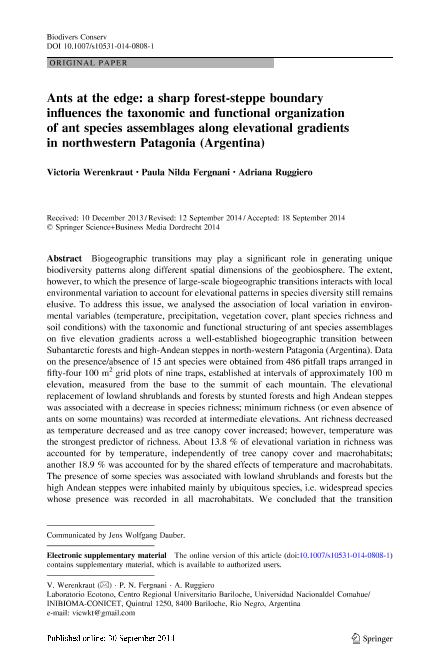Artículo
Ants at the edge: a sharp forest-steppe boundary influences the taxonomic and functional organization of ant species assemblages along elevational gradients in northwestern Patagonia (Argentina)
Fecha de publicación:
09/2014
Editorial:
Springer
Revista:
Biodiversity And Conservation
ISSN:
0960-3115
Idioma:
Inglés
Tipo de recurso:
Artículo publicado
Clasificación temática:
Resumen
Biogeographic transitions may play a significant role in generating unique
biodiversity patterns along different spatial dimensions of the geobiosphere. The extent, however, to which the presence of large-scale biogeographic transitions interacts with local environmental variation to account for elevational patterns in species diversity still remains
elusive. To address this issue, we analysed the association of local variation in environmental variables (temperature, precipitation, vegetation cover, plant species richness and soil conditions) with the taxonomic and functional structuring of ant species assemblages on five elevation gradients across a well-established biogeographic transition between Subantarctic forests and high-Andean steppes in north-western Patagonia (Argentina). Data on the presence/absence of 15 ant species were obtained from 486 pitfall traps arranged in fifty-four 100 m2 grid plots of nine traps, established at intervals of approximately 100 m elevation, measured from the base to the summit of each mountain. The elevational replacement of lowland shrublands and forests by stunted forests and high Andean steppes was associated with a decrease in species richness; minimum richness (or even absence of ants on some mountains) was recorded at intermediate elevations. Ant richness decreased as temperature decreased and as tree canopy cover increased; however, temperature was
the strongest predictor of richness. About 13.8 % of elevational variation in richness was accounted for by temperature, independently of tree canopy cover and macrohabitats; another 18.9 % was accounted for by the shared effects of temperature and macrohabitats. The presence of some species was associated with lowland shrublands and forests but the high Andean steppes were inhabited mainly by ubiquitous species, i.e. widespread species whose presence was recorded in all macrohabitats. We concluded that the transition between the Subantarctic forests and high Andean steppes represents a sharp barrier to ant
species? elevational distribution. This, in association with elevational variation in continuous environmental functions, mainly temperature, influences the richness and taxonomic and functional structuring of ant species assemblages at temperate latitudes of the southern hemisphere.
Archivos asociados
Licencia
Identificadores
Colecciones
Articulos(INIBIOMA)
Articulos de INST. DE INVEST.EN BIODIVERSIDAD Y MEDIOAMBIENTE
Articulos de INST. DE INVEST.EN BIODIVERSIDAD Y MEDIOAMBIENTE
Citación
Ruggiero, Adriana; Werenkraut, Victoria; Fergnani, Paula Nilda; Ants at the edge: a sharp forest-steppe boundary influences the taxonomic and functional organization of ant species assemblages along elevational gradients in northwestern Patagonia (Argentina); Springer; Biodiversity And Conservation; 24; 2; 9-2014; 287-308
Compartir




